To start off with, this title has nothing to do with that other character in the flock, Kilas, in the film directed by Fonseca e Costa. Even so, Macau was surprised by the Kira (artistic pseudonym of António Joaquim Pereira Gama) who gave his debut exhibition in the Gallery of the Livraria Portuguesa (Portuguese Bookshop), an exhibition of twenty three works which by no means were characteristic of his style. Where was the Kira who uses an aggressive visual approach to colours, colours which at times imitate the fauvists? Where was the Kira of ossified structures in peopled urban landscapes, of the tricycle ride through the honeycomb of geometrical projections, of those Aphrodisiacal hills which he paints with libidinous subtlety?
On the contrary, Kira offered Macau two dozen nostalgic glimpses of the Alentejo, of the gleaming whiteness, of the whitewashed houses, of the occasional sunshine.
He revels in a chalky solitude, recalling places of his childhood. The sea appears exactly three times, an intense blue which brings to mind golden memories of some journey by boat. Kira, the child, is depicted dressed in shorts and a striped sailor top in what is perhaps no more than a fantasy dreamt, enveloped in the undulating folds of his striped nursery sheets.
Kira dismantles the urban environment, destroying the tangle of human flesh to reveal a scene where he has replaced the fundamental elements, now synthetic, geometrically purified. Colour and structure now reign victorious under the Kira we know.
White persists with temporal permanence, agoraphobia (although his paintings portray large, open spaces), subtle texturing - all of these attest to an ongoing, eloquently expressed popular participation. The row of houses faded by the sun, dusted lightly by a time which seems to have leaked from a broken hourglass and the florid, sensual exaltation seen in the painting Noiva-Primavera (Fiancée in Spring) and the other Primaveras with sturdy, rounded bodies reflect a Kira in different circumstances from those which Macau previously knew.
So why call him a "black sheep"? Merely because we had not anticipated this plastic offering which concentrates so heavily on white and calm. The title has been taken from a film because it complements the cinematic effects in his painting-his brush captures both rhythm and stills (he has an obsession with detail), moving across objects and blurring them until he reaches fade-out...
Translated by Alorino Noruega
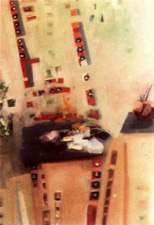
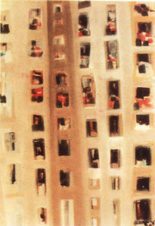
CHINESE CINEMA IN PORTUGAL
From October until the beginning of November the Portuguese Film Theatre in Lisbon held a season of Chinese cinema organized by the Portuguese Film Theatre and the Cultural Institute of Macau and patronized by the Embassy of the People's Republic of China. Films from 1925 to 1985 were shown with particular emphasis on films from the Thirties and the Eighties.
A catalogue was produced for the occasion by José Costa and Gil Abrunhosa with contributions from Portuguese and foreign specialists on cinema. Both the graphics and the printing are of high quality.
This lovely book successfully conveys an organized account of what was and continues to be the History of Chinese Cinema.
Translated by Nelly Visser
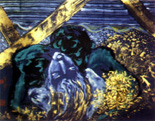
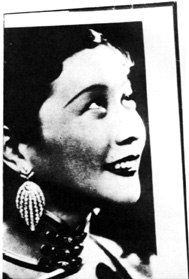
KO BOU TSIU IN MACAU
On the 5th of December the paintings of Hong Kong artist Ko Bou Tsiu were exhibited in Macau as a result of collaboration between the Alliance Française and the Cultural Institute of Macau.
The works, displayed in the new wing of the Hotel Lisboa, reflected an unequalled conceptual and technical merit highlighted by one dominating impulse - to destroy the passivity of a tradition which, in the artist's consideration, limits creativity, intimacy and innovation.
As the artist says:
'I am, by nature, a very emotional person. All my thoughts, feelings, ideas, ambitions as well as my philosophy on life are expressed through my paintings, poems and writings.
Not so long ago any criticism was likely to produce an unexpected, counterproductive response. This is why the Chinese tradition saddens me; it prevents people from showing their true feelings and tendencies. According to this philosophy, not expressing pleasure, anger, sadness or happiness is seen as the highest principle of self-control. But this kind of abnormal behaviour can produce cold, insensitive people.
If there is no true love between people then the world will become a cold, cruel place which deprives us of any reason to continue living.
Moreover, an education based on excessive respect between parents and children, siblings, friends, couples and even lovers is so deeply rooted in the Chinese tradition that it is unusual to find frank communication between them. This leads to a situation where nobody can tell what others are thinking nor can they themselves be understood. This is tragic!
In the past most Chinese painters were deeply conditioned by the fact that they inherited ideas from only one master. Their personal feelings can seldom be traced in their own works. They lack the open mind of the West and they don't take the risk of free creativity which would guarantee them innovation".
Books of the Quarter
The editorial section of ICM is proud to present these works by Luís Gonzaga Gomes, formerly an eminent figure in the cultural life of Macau. Firstly, there is a republication of "Bibliografia Macaense", a facsimile version of an off-print from the "Boletim do Instituto Luís de Camões", vol VII, no1, published in 1973.
As the edition was out of print, the republication is intended to assist researchers and readers and to stimulate a better understanding of the history of Macau. The original work reflects Gonzaga Gomes, vast Knowledge of the history and bibliography of Macau but it has now been reorganized and brought up to date.
This publication represents the first in what the ICM intends to be a complete record of bibliographical works on Macau. They will be published on an annual basis as the "Boletim da Bibliografia Macaense" and will begin by including bibliographical works published from 1973. The groundwork for this project is the responsibility of the National Library and the Historical Archives of Macau.
These two institutions, which consitute part of ICM, have produced a catalogue entitled "Exposiçãlo Fotobibliográfica - Luís Gonzaga Gomes" which has also been published by the editorial section of ICM. The catalogue is an exhaustive reference work on the writings (both in original and translated versions) of Gonzaga Gomes and photographs from the family estate donated by the author's sister, Senhora D. Maria Margarida Gomes. There is a biographical preface by Jorge Abreu Arrimar which evokes and describes his life and activities as teacher, musicologist, ethnographer, historian, librarian, sinologist, researcher, journalist and supporter of several institutions in Macau. There is also a testimony by Dr. Túlio Tomás. This book is an essential reference work for the life and works of Gonzaga Gomes.
The Historical Archives of Macau have again collaborated with the editorial section of ICM in publishing "Archives of Macau" vol. V, bk. II in the Fourth Series. This is the "Bulletin of the Historical Archives of Macau" for the period from July to December of 1985. It concentrates mainly on the Civil Administration Foundation, publishing a systematic account of the years 1918, 1919 and 1920.
Macanese philately (from the beginning of its short history up to the present day) has now been recorded in a complete catalogue, written by collector and philatelist Kong lat Cheong and published in a trilingual edition (Chinese, Portuguese and English) by the editorial section of ICM. It will allow greater knowledge and exchange amongst the world community of philatelists in addition to spreading information about Macau, its history, its cultural heritage, its countryside, its art and its famous personalities abroad. Since its foundation on the 1st of March, 1884, Macau's Post Office has issued over a hundred cover editions which have been divided into four periods and are presented in the catalogue in the following sections: commemorative and definitive stamps; air mail; welfare stamps; first day covers; unreleased stamps.
In an attempt to satisfy philatelists and collectors, the book includes colour reproductions of all the coloured stamps, an unusual feature in books of this nature.
"Can you Use Chopsticks?" is the title of another book published by ICM this quarter. It has also been co-released in Portugal in an edition by Publica Press. Its contents deal with those Chinese recipes which can most easily be prepared by Portuguese cooks. There is an introduction on Chinese cooking, ingredients, preparation and utensils.
Written by the Macanese journalist Cecília Jorge with a preface by Maria Lourdes Modesto, the one hundred and sixty pages of this book, with excellent graphics directed by António Conceição Júnior and photography by Amílcar Carvalho promise strong commercial competition.
Macau's Artists, 87.
For the fourth year running the Leal Senado, assisted by the Luís de Camões Museum, organized the Collective Exhibition of Macau's Artists, an initiative which is intended to monitor the development of visual arts in the Territory and to be thought-provoking.
As in the previous exhibitions, the exhibition was divided into three different sections: Chinese Painting, Calligraphy and Western Painting. The sections were judged by a panel of distinguished artists, historians and art critics from Macau and Hong Kong.
In the introduction to the catalogue António Conceiçãto Júnior said that, when judging paintings, he favoured "innovation and creativity expressed in a recognisable form'.
The prizes for Calligraphy and Chinese Painting were awarded to Lao Pak On and Lok Tai Tong respectively.
RC is happy to announce that the winner of the Western Painting Section was Carlos Marreiros, Sub-Editor and Artistic Director of RC, for his work "Pessanha and Mask" ( 124cm by 124cm, pencil and acrylic on canvas).
Forming part of what Marreiros hopes will be a series of portraits of great figures who have contributed to Macau's culture, "Pessanha and Mask" is outstanding in its adoption of a difficult and lately neglected artistic style and complex, live symbolism in which the painter's strong personality is reflected.
Translated by João Libano
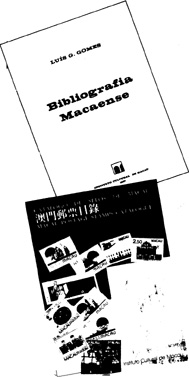
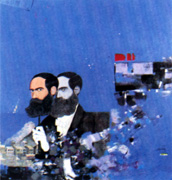
"Pessanha and Mask" Carlos Marreiros
start p. 115
end p.